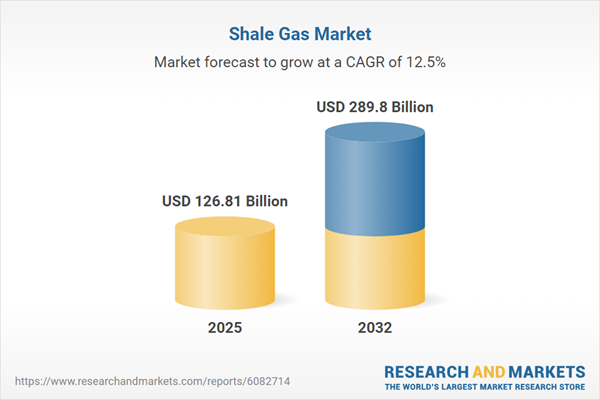Speak directly to the analyst to clarify any post sales queries you may have.
The shale gas market is undergoing significant change, requiring senior decision-makers to reassess traditional strategies. With evolving technologies, shifting regulations, and global sustainability priorities influencing every facet of operations, market leaders must prioritize adaptability and informed decision-making to secure both immediate and long-term growth.
Shale Gas Market Snapshot
The global shale gas market is moving through a phase of notable expansion. In 2024, the market stands at USD 112.93 billion, set to increase to USD 126.81 billion in 2025, and anticipated to approach USD 289.80 billion by 2032, demonstrating a compound annual growth rate (CAGR) of 12.50%. This robust growth highlights demand for lower-carbon energy across sectors such as industry, power generation, and transportation. Contributing factors include ongoing improvements in extraction processes, increased adoption of sustainable technologies, and the need for cleaner fuel sources. Organizations are strategically leveraging advanced digital systems and entering partnerships to remain resilient as market expectations and technology landscapes evolve.
Scope & Segmentation of the Shale Gas Market
This report provides a comprehensive review of critical aspects shaping the shale gas market. By analyzing extraction technologies, product classifications, gas quality, primary uses, key regions, and company strategies, it reveals actionable insights for leaders looking to harness new opportunities and manage operational complexities.
- Extraction Techniques: Horizontal drilling, hydraulic fracturing, multistage and waterless fracturing are increasing resource recovery and operational efficiency across resource basins.
- Product Types: Shale-derived butane, ethane, methane, and propane serve diverse roles as chemical feedstocks and fuels for varied industrial applications.
- Purity Levels: The distinction between dry gas and wet gas directly impacts processing steps and downstream end uses.
- Applications: Broad applications include chemical production (such as methanol and polyethylene), industrial processes in manufacturing and petrochemicals, distributed and utility-scale power generation, residential heating and cooking, as well as transportation fueled by CNG and LNG vehicles.
- Regional Coverage: The Americas (with detail on North America and Latin America), Europe, the Middle East and Africa, and Asia-Pacific shape the global market, each adapting to local regulatory priorities and supply chain dynamics.
- Key Companies Profiled: The analysis spotlights leading shale gas firms including EQT Corporation, Range Resources Corporation, Chesapeake Energy Corporation, Southwestern Energy Company, CNX Resources Corporation, Antero Resources Corporation, Cabot Oil & Gas Corporation, Chevron Corporation, Exxon Mobil Corporation, and ConocoPhillips.
Shale Gas Market: Key Takeaways for Leadership
- Real-time data analytics, digital twins, and improved fracturing methods are driving operational improvements, enabling smaller enterprises to better compete with established players.
- Changes in environmental and regulatory frameworks are prompting companies to strengthen monitoring and sustainability programs, ensuring compliance and supporting climate-focused initiatives.
- Integration of shale production with renewable sources is advancing the flexibility of energy systems, assisting in grid reliability and enabling expanded use of cleaner fuels in transportation.
- Market participants are diversifying portfolios with gas-to-liquids projects, carbon capture implementations, and investment in value-added chemical production as part of long-term business resilience.
- Supply chain volatility—shaped by tariffs and logistical issues—requires new risk management techniques, including near-shoring and collaborative supplier partnerships to reduce potential disruptions.
- Collaboration across the value chain, from technology developers to end-users, is increasingly essential for meeting both commercial and environmental objectives.
Tariff Impact on the Shale Gas Value Chain
Recent US tariff adjustments affecting tubular goods and drilling equipment have elevated manufacturing and operational costs throughout the shale gas supply chain. Large integrated market leaders are leveraging procurement strategies and scale to control expenses, while smaller firms are reconsidering project scopes and scheduling. In downstream segments, operators are emphasizing shared infrastructure to retain efficiency, and exporters are refocusing on international pricing in response to evolving trade policies.
Methodology & Data Sources
This report utilizes insights from over fifty primary interviews with top executives and technical experts, supported by targeted secondary research from sector publications and proprietary industry datasets. Scenario analysis and model-based sensitivity testing were reviewed by a panel of experienced consultants, ensuring the report’s findings deliver actionable and reliable guidance.
Why This Report Matters for Shale Gas Strategy
- Integrates technology, policy, and investment perspectives, clarifying how transformative shifts shape future market direction for shale gas operations.
- Offers clear actions for anticipating regulation changes, mitigating supply chain risks, and fulfilling environmental responsibilities to optimize ongoing performance.
- Enables robust risk assessment and strategic capital allocation, supporting senior leadership in managing volatility and seizing growth opportunities.
Conclusion
As the shale gas market continues to evolve, operational agility, innovation, and well-informed planning are key for sustained performance. Senior decision-makers equipped with quality insights will be best positioned to navigate complexity and secure lasting competitive benefits.
Table of Contents
3. Executive Summary
4. Market Overview
7. Cumulative Impact of Artificial Intelligence 2025
List of Figures
Companies Mentioned
The companies profiled in this Shale Gas market report include:- EQT Corporation
- Range Resources Corporation
- Chesapeake Energy Corporation
- Southwestern Energy Company
- CNX Resources Corporation
- Antero Resources Corporation
- Cabot Oil & Gas Corporation
- Chevron Corporation
- Exxon Mobil Corporation
- ConocoPhillips
Table Information
| Report Attribute | Details |
|---|---|
| No. of Pages | 183 |
| Published | November 2025 |
| Forecast Period | 2025 - 2032 |
| Estimated Market Value ( USD | $ 126.81 Billion |
| Forecasted Market Value ( USD | $ 289.8 Billion |
| Compound Annual Growth Rate | 12.5% |
| Regions Covered | Global |
| No. of Companies Mentioned | 11 |









